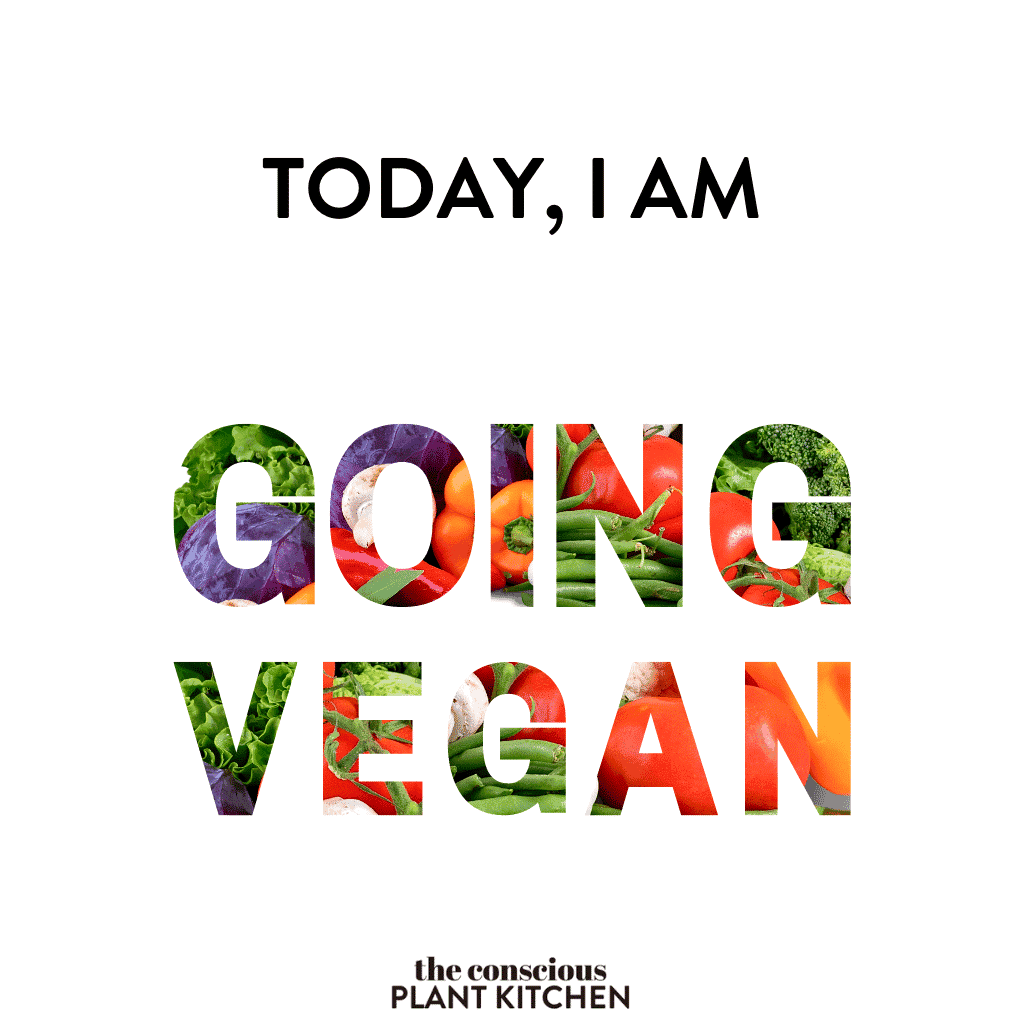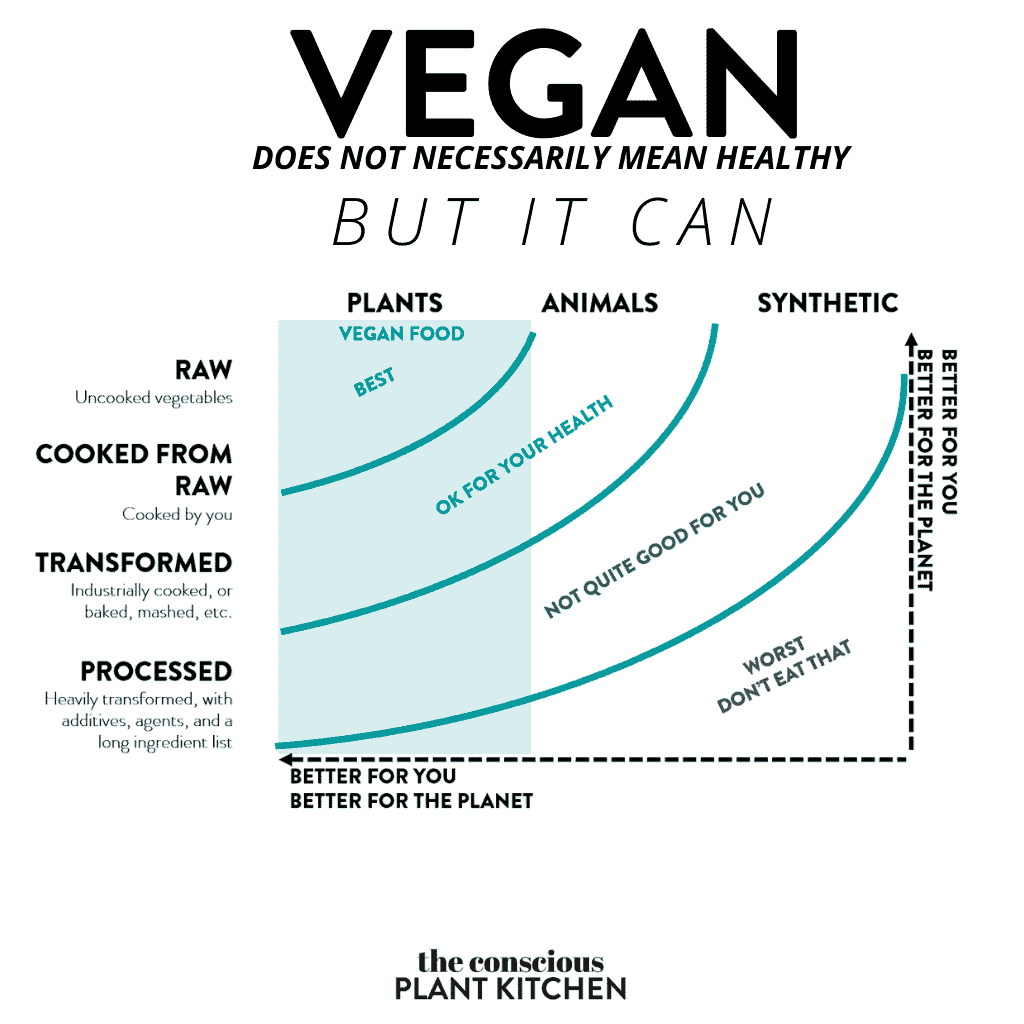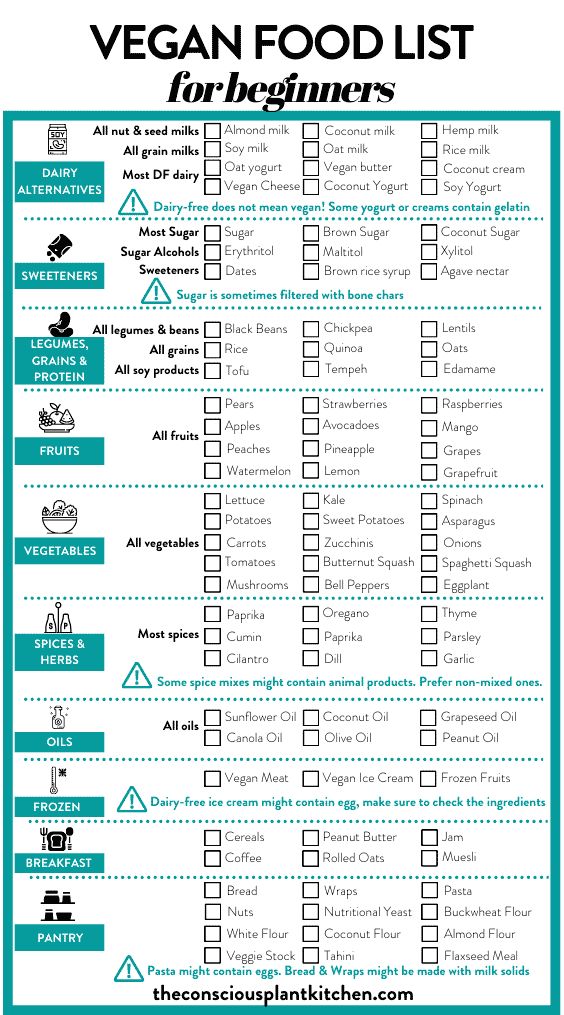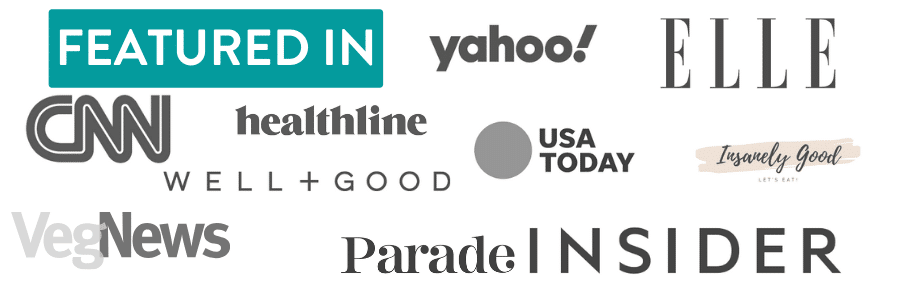Going vegan is one of the best decisions you can make for yourself, the animals, or the planet.
It is estimated that about 1% of the population follows a vegan lifestyle and 5% of the population eats a plant-based diet.
The vegan lifestyle goes beyond just what you eat, but this article will tell you all you need to know about the vegan diet!

I have been vegan for many years, and I have influenced people around us to go vegan, so I can help you as well!
1. Why Going Vegan?
Before going any further, it’s important to know why you want to go vegan.
There are typically three main reasons people have to go vegan. Each person will feel more or less strongly about each cause, and that will drive the way they approach the vegan diet and lifestyle:
- For yourself: the vegan diet has many health benefits.
- For the animals: to reduce the harm done to animals.
- For the planet: to reduce the environmental impact of eating animal products.
People go vegan for one or a combination of these reasons.
To learn more about the vegan lifestyle in general, read my article on veganism.
2. Is The Vegan Diet Healthy?
That will depend on you. Vegans can choose to eat anywhere from very healthy to 100% junk food!
The fact that you go vegan does not necessarily mean you will eat healthily unless you choose to.
It is now just as easy to find heavily processed vegan food as it is to find heavily processed animal food.
Many fast-food chains are starting to offer vegan options.
This is great to lure more people to the vegan diet and reduce the environmental impact of these fast-food restaurants, but eating that sort of food day-in-day-out won’t help your health.

3. What Can I Eat, What Can’t I Eat?
There are a number of foods and ingredients that are not vegan-friendly.
Not vegan
All animal products:
- Meat
- Fish
- Eggs
- Gelatin
All products produced by animals:
- Honey
- Milk and other dairy products
There are also some products you wouldn’t think are not vegan. To find out more, read my vegan grocery list.
Vegan
All products that don’t contain animal products:
- Fruits
- Vegetables
- Legumes
- Seeds, nuts
- Spices
- Vegan alternatives: vegan milk, vegan cheese, vegan yogurt, etc.
Please read my full article to understand how to build your vegan shopping list, or grab the list below!

4. How Can I Balance My Vegan Diet?
A common question and a frequent issue for new vegans is whether they will have enough iron, vitamins, protein, etc., in their new diet.
The vegan diet is not so different from any other diet because if you always eat the same processed food, you will develop deficiencies in vitamins or minerals.
As a result, it is essential to eat a varied, balanced, wholesome diet. And remember, going vegan is not about eating salads every meal!
When you go vegan, the biggest difference you will find on your plate is the absence of meat, eggs, dairy, and fish. So, it is possible to see the balance of the following nutrients altered:
Protein
Meat is rich in protein, so you will need to find a vegan source of protein. There are many protein-loaded vegan products like nuts, seeds, grains, pulses, soybean products, etc.
You will find that it is actually much easier than you think to have your daily protein dose.
Keep in mind that it is recommended to take at least 0.8 grams of protein per kilogram of body weight. A typical adult of 70 kg needs at least 56 grams of protein per day, which you find in 70 grams of tofu!
Iron
Red meat is particularly rich in iron. The recommended Iron intake varies greatly depending on your age, gender, pregnancy status, and activity level.
Beef has about 14% of the recommended intake per 100 grams. This is the same as half a cup of quinoa or 50 grams of tofu!
To learn more about that, read my guide on vegan sources of iron.
Vitamins (B12 in particular)
Vitamins are micro-nutrients that are necessary for your body to function but that we are not able to produce ourselves.
Therefore, we need to find them in our food.
Most vitamins are easy to find in vegetables and legumes, but Vitamin B12 is the trickiest one. You need only trace amounts of B12, but it is mostly only found naturally in animal products.
So the best way for vegans to get their B12 is to take products fortified in Vitamin B12 or B12 supplements.
Here are a few examples:
- Fortified Cereals: between 10% and 150% of your recommended intake per serving.
- Nutritional Yeast: 300-600% of your recommended intake per serving.
- Marmite/Vegemite: 25% of your recommended intake per serving.
- Milk Alternatives: between 5% and 20% of your recommended intake per serving.
Should I Get Blood Tests?
Yes! It doesn’t hurt, and it only takes a few minutes to get your blood taken. Full blood work will check your vitamins, iron, minerals, and many of the possible deficiencies.
If you are not sure how to approach it, read this article from a no-meat athlete about getting a proper blood test!
5. Will I Miss Meat, Milk, Or Cheese?
That depends. If you did like meat or dairy products before going vegan, you will, of course, miss these!
When the body is used to getting something it enjoys, it has a hard time saying goodbye.
Let me tell you how you can overcome this and what alternatives you can find.
Meat alternatives
There are more and more vegan meat alternatives every day. Let’s have a look at what exists from the healthiest options.
a. Make your own patties
You can easily make your own meat-less patties. Check out my black bean burgers if you’re not convinced. They are easy to do and taste delicious.
b. Make your own chicken
You can make your own chicken replacement at home! The best way to do that is to use Jackfruit.
When cooked, in particular, if you roast it in the oven, Jackfruit tastes a lot like shredded chicken.
c. Tofu slices
Another quick swap for meat is to take a good Tofu slice marinated in spices or barbecue sauce. Let’s face it. What tasted good in meat is not the meat. It’s the spices and sauce!
And if you want something with a stronger taste than Tofu, you can opt for Tempeh.
d. Falafels
Falafels are easy to make at home from a can of chickpea and some spices, but you can also find delicious falafels in-store.
EatGud, Tarazi are some good brands you can find anywhere.
e. Legume patties
You can find many legume-based patties in-store. Made from beans, legumes, or even some grains, these patties are healthy, simple, and nourishing.
Note that these patties don’t try to mimic meat, so don’t expect the same juicy sensation.
f. Pea-based patties
Pea-based patties have been introduced to mimic meat as much as possible. Some brands even go to the point of adding coconut oil (solid in the fridge) to make the pattie look like meat and sound like meat when it sizzles.
These patties are often made with beetroot juice to reproduce the red color of a meat patty. If you want the most meat-like taste and texture, they are the ones to go for.
Brands like Meatless Farm, Beyond Meat, Impossible Foods, Alternative Meat make good pea-based patties.
g. Seitan
Seitan is essentially gluten. So, if you are intolerant or allergic to gluten, stay away. If not, it is a product that has a very meaty texture when cooked.
You can find Seitan made by Upton’s Natural, Sweet Earth.
h. Alternative Sausages
From hotdogs to frankfurters and breakfast sausages, there is now every single type of vegan sausage available.
Check out Sweet Earth, Beyond Meat, Field Roast, Lightlife.
i. Alternative Chicken
There are so many ways to replace chicken and find the same taste! From chicken strips (Sweet Earth) to nuggets (Hodo, Gardein, Tofurky, No Evil).
j. Alternative Bacon
To replace your bacon, you can find many vegan alternatives. They are either made from pea protein, seitan, or even coconut! In fact, you can make your own bacon with young coconut strips marinated in barbecue sauce!
You can also make your own bacon with slices of eggplant!
But if you want to buy alternative bacon, brands like Yves, Upton’s Naturals, Sweet Earth, Lightlife make solid choices.
Fish alternatives
There are now some fish alternatives available.
Granted, most of them are just panned fish alternatives, but they have the merit to exist.
The best way to make your own fish and chips is to find Banana Blossoms.
Banana blossoms end up tasting very similar to white fish when cooked.
Milk alternatives
There are now many milk alternatives available everywhere.
In your supermarket, you can find:
- Almond milk
- Soy milk
- Oat milk
- Coconut milk
- Rice milk
- Cashew milk
Brands such as Almond Breeze, Oatly,
But also some more complex blends. Mylk, produced by Rebel Kitchen, is a milk alternative that is incredibly tasty and fortified in various B-vitamins.
Yogurt follows the same trend. You can now find yogurt made from soy, coconut, and almonds very easily!
Cheese alternatives
Cheese is a bit more complex than milk because you would generally expect one thing: it needs to melt.
Many vegan cheese brands exist now that have had varying levels of success in reproducing cheese.
As a result, it is better to try a few brands. Some are better raw. Some are better melted.
But you should be able to find everything you need, from pizza cheese (Daiya) to burger slices (Field Roast, Daiya, Miyoko’s Creamery) or even cream cheese (Kite Hill, Tofutti).
There are even some very convincing Feta (Violife) or fresh Mozzarella (Miyoko’s Creamery) available.
6. Where Can I Buy Vegan Products?
Everywhere!
No, for real, now all shops, small and large, have a vegan section. Some have an entire aisle with vegan products. In some shops, vegan products are just next to their non-vegan counterparts.
There are two very easy ways to find grocery stores that sell vegan foods where you are:
- Using Google, searching for Vegan Grocery Stores near me.
- Using Happy Cow. Happy Cow is an application and website where you can find vegan-friendly stores and vegan-friendly restaurants.
7. How Can I Eat Vegan In Restaurants?
Many restaurants are vegan-friendly these days. Some restaurants are 100% vegan, but you can also find vegan-friendly food in the vast majority of classic restaurants.
Make sure you either ask which items are vegan on the menu or that the legend is clear! Some restaurants mark vegan items with a V, while some mark them with VG. Be careful since Vegetarian menu items can also be found with either V or VG!
To find a vegan-friendly restaurant, there are a few options:
- Using Google, searching for Vegan Restaurants near me. Make sure to read the reviews!
- Using Happy Cow again! The app allows you to filter the restaurants using several useful criteria.
- Join a local vegan group on Facebook. There are groups in most major cities where you can find what restaurants others have found and liked.
While Vegan food is most of the time easy to find on a menu, it is not the same at all with drinks.
Finding a vegan-friendly wine or beer is much more difficult than you might think.
- Wine is often made with egg proteins or with milk casein. Wine is, most of the time, not Vegan.
- Beer is rarely made with animal-derived fining agents like gelatin. Beer is, most of the time, Vegan.
If you are in doubt and want to check, Barnivore is a library that contains many beers and wines and tells you whether they are vegan-friendly or not.
8. How Can I Explain Veganism To Friends And Family?
Believe me. Not everyone will understand why you are going vegan.
Some of your friends and family will be supportive.
But some won’t. And some will even try to make you trip on your vegan journey, trying to sneak some meat in a pie, or some milk in a smoothie, just to see how you react.
For all those around you that at first won’t understand why you are going vegan, be prepared. You’ll need some arguments.
- Explain why. Tell them why you are doing this. For the animal, for the planet, for you. They will try to counter-argument, so if you feel like engaging in a discussion, come with some stats and data 😉.
- Help them realize their own contradictions: You support meat-eating, but eating a dog repulses you. Why? You want to help the environment, but the meat industry by itself emits 15% of the global greenhouse gas.
- Be ready for questions on what is vegan or on veganism:
- Is meat vegan?: No
- Are eggs vegan?: No
- Is honey vegan?: No
- Is fish vegan?: No
- Are lollies/candies vegan?: It depends
- Is leather vegan?: No
- But plants feel pain too?: They don’t have a nervous system, so they don’t feel pain.
- Don’t cows need to be milked?: No, they don’t! They produce milk because we pump it. It’s not the other way around.
- But it contains traces of milk/eggs!: This is going to be your decision. In most cases, this is just a disclaimer, mostly to deter very allergic people. Do you care if there are traces? Well, that is for you to answer!
- But it is cooked on the same grill as meat!: That’s a similar problem as the traces of eggs/milk. Is it a problem for you? Would you change restaurant for this? It’s a personal choice.
9. Where Can I Find Good Vegan Recipes?
There are now hundreds of excellent vegan websites where you can find great recipes, from Breakfast recipes to lunch recipes, dinners, snacks, cakes, drinks, appetizers, etc.
We have many recipes on The Conscious Plant Kitchen but don’t hesitate to try out recipes from other blogs like:
11. Can I Lose Weight By Eating Vegan?
Yes.
But it’s not the point.
You can lose weight on a vegan diet, just the same as you can lose weight on a regular diet. Not more. Not less.
According to most doctors and dietitians, losing weight is a matter of reducingcalorie intake. This can be achieved through many diets.



Would maple syrup be considered vegan?
100%!
How do people with osteoporosis follow a vegan eating plan?
Hi there,
We can’t comment on that as we’re not doctors. Any medical condition needs to be discussed with your doctor.
bonjour carine et Damien, moi aussi je suis “vegan” mais seulement a 90%. si tout le monde faisait ca-ca aiderais bien notre planette et notre santé. merci pour les info. anne de Chicago. ps: je veux bien vos recettes.
Merci beaucoup!
With respect, I believe you have a mathematical error in your protein calculation.
If a person needs .8 grams of protein per kg each day, then daily requirement for a 70 kg person would be 56 grams and not 5.6 grams as stated in your article.
The amount of tofu needed to fulfill that requirement would be 10 times your recommendation, or 700 grams.
Thanks for spotting the typo. It’s updated now.